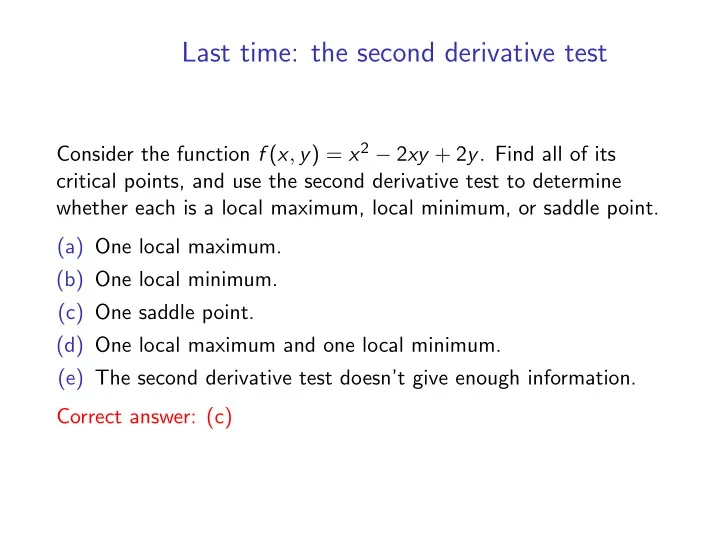

Last time: the second derivative test Consider the function f ( x , y ) = x 2 − 2 xy + 2 y . Find all of its critical points, and use the second derivative test to determine whether each is a local maximum, local minimum, or saddle point. (a) One local maximum. (b) One local minimum. (c) One saddle point. (d) One local maximum and one local minimum. (e) The second derivative test doesn’t give enough information. Correct answer: (c)
2 nd D.T. for quadratic polynomials Let g ( x , y ) = ax 2 + bxy + cy 2 , with a ̸ = 0. It has a critical point at (0 , 0), and we want to determine whether this is a local maximum, a local minimum, or a saddle point. We checked last time that D = 4 ac − b 2 . We started by trying to find other points ( x , y ) where g ( x , y ) = (0 , 0) so we can place restrictions on where g is positive and negative. ( by ) 2 − 4 acy 2 √︁ ax 2 + bxy + cy 2 = 0 ⇒ x = − by ± 2 a √ = − b ± − D y . 2 a
If D > 0, there are no solutions, so (0 , 0) is the only place where g = 0. This tells us that either g > 0 everywhere else (and so 0 is a local minimum), or g < 0 everywhere else (and so 0 is a local maximum). Note that g xx (0 , 0) = 2 a and also that g (1 , 0) = a . ∙ So if g xx (0 , 0) < 0, we must have g ≤ 0 everywhere, and 0 is a local maximum. ∙ Likewise it g xx (00) > 0, we must have g ≥ 0 everywhere, and 0 is a local minimum. On the other hand, if D < 0, there are two lines of solutions to the equation g ( x , y ) = 0, forming a cross. Since g is a quadratic polynomial, it must take both positive and negative values, and (0 , 0) must be a saddle point.
This is why the second derivative test works for g ( x , y ) at the critical point (0 , 0).
The boundary of a region D Consider the boundary of D = [ p , q ) ⊂ R . How many points are in the boundary? (a) 0 (b) 1 (c) 2 (d) Infinitely many. Correct answer: (c)
Let D ⊂ R 2 be the set {︃ 0 ≤ x ≤ 3 }︃ . 0 ≤ y ≤ 2 Is it closed? Is it bounded? (a) It is not closed or bounded. (b) It is not closed but it is bounded. (c) It is closed but it is not bounded. (d) It is closed and bounded. Correct answer: (d)
Recommend
More recommend